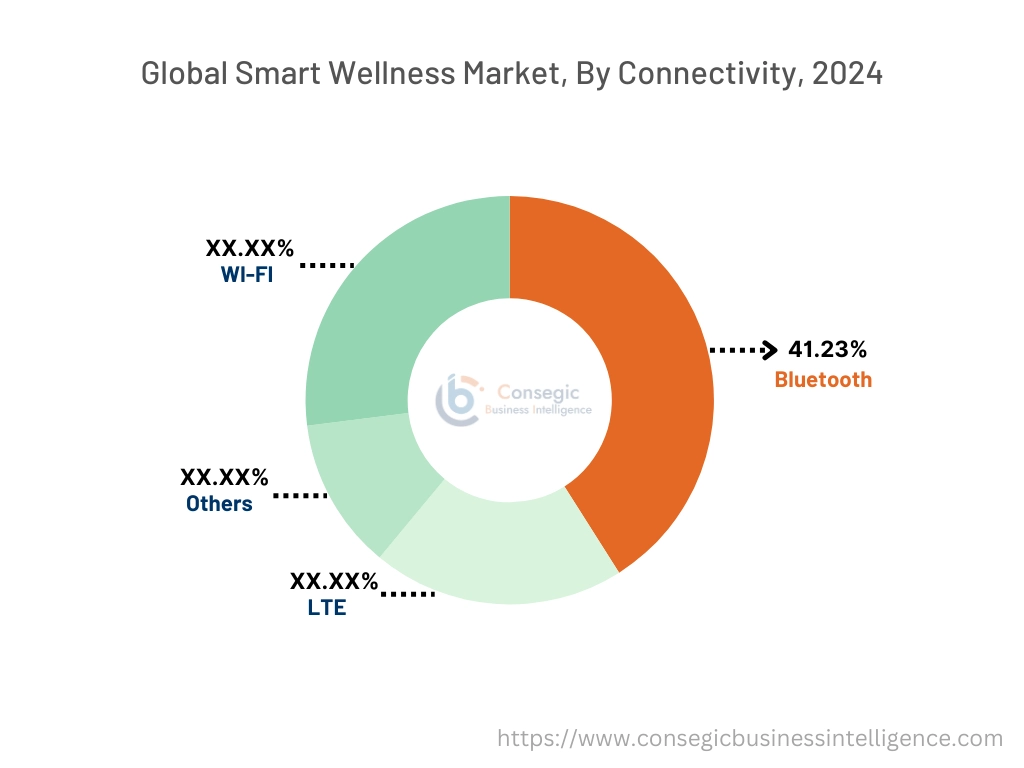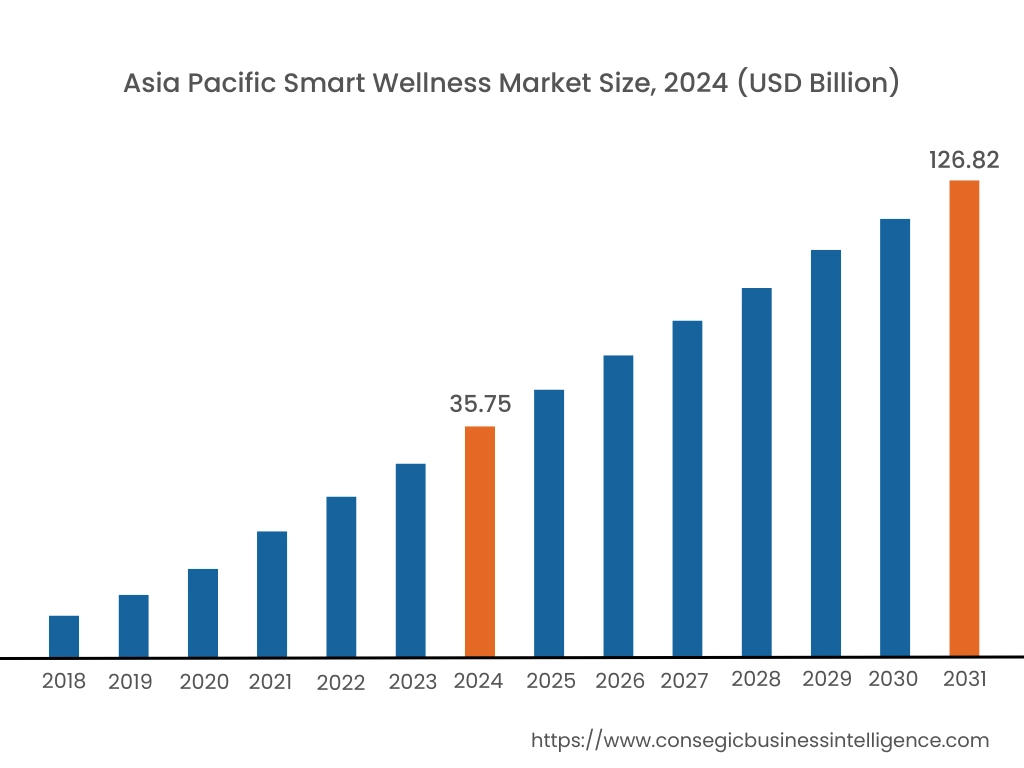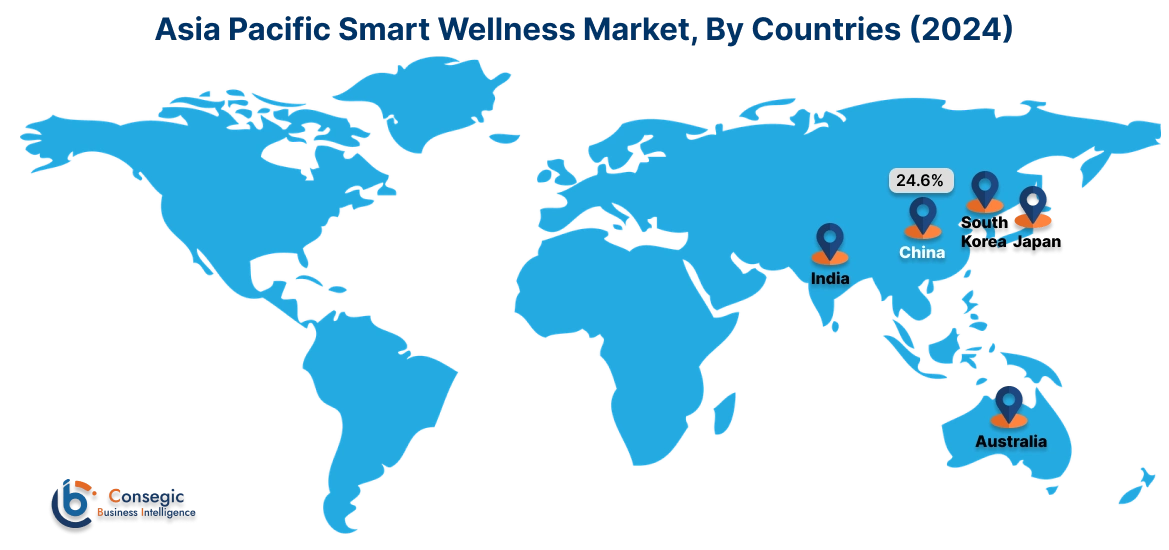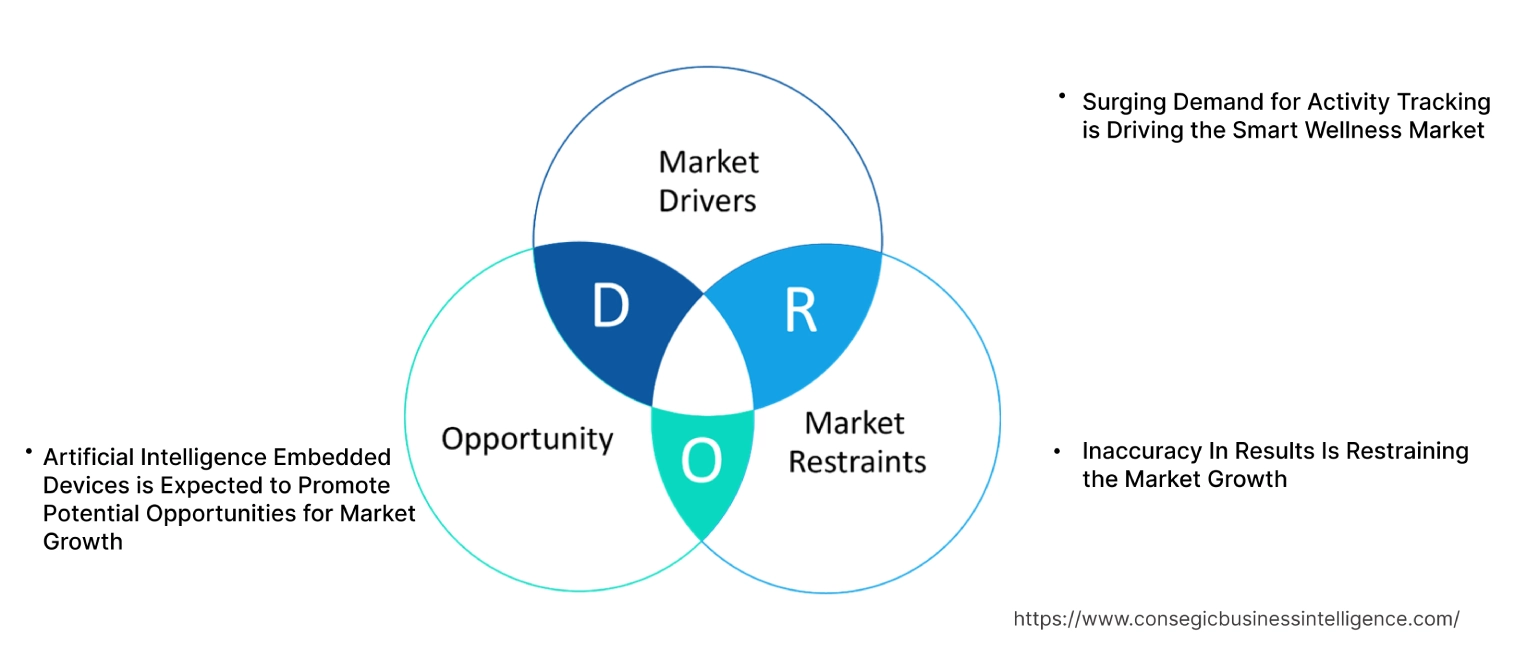- Summary
- Table Of Content
- Methodology
Smart Wellness Market Size:
Smart Wellness Market is estimated to reach over USD 457.16 Billion by 2032 from a value of USD 135.23 Billion in 2024 and is projected to grow by USD 155.12 Billion in 2025, growing at a CAGR of 18.4% from 2025 to 2032.
Smart Wellness Market Scope & Overview:
Smart wellness consists of an extensive range of high-quality devices and accessories that monitor, treat, and prevent various health conditions and significantly enhance healthcare outcomes. Moreover, hospitals and individuals are leveraging the latest technologies to take control of health and well-being. Additionally, the devices are used to monitor various parameters such as heart rates, step counts, calories burned, sleep tracking, and others driving the smart wellness market growth. The benefits of adopting devices and accessories include increased convenience, improved navigation, flexibility, enhanced monitoring, and more. Further, the consumer shift towards healthcare wellness is fueling the smart wellness market share. Furthermore, the increasing need for real-time health monitoring devices and accessories is driving the smart wellness market size.
Key Drivers:
Surging Demand for Activity Tracking is Driving the Smart Wellness Market
The prevalence of various health disorders including high blood pressure, diabetes, and asthma among others is propelling the need for fitness trackers, smart watches, sleep trackers, and others in turn fueling the smart wellness market. Further, the consumer shift towards self-tracking various body vital such as heart rates, step count, burned calories, and others is boosting the market progress. Moreover, the devices significantly help in tracking changes in weight, body composition, and activity levels over time, allowing users to adjust routines and dietary choices accordingly.
- For instance, in August 2021, according to the World Health Organization and Imperial College London, the number of hypertension cases increased from increased from 650 million to 1.28 billion in the last thirty years Therefore, an increasing number of hypertension cases drives the need for smart heart rate monitoring devices which in turn fuels smart wellness market size.
Thus, the rising number of various health disorders is driving the demand for smart wellness market growth.
Key Restraints:
Inaccuracy In Results Is Restraining the Market Growth
Individual consumers and hospitals leverage various smart devices, fitness trackers, and sleep trackers for keeping a record of various body vital parameters such as heart rates, oxygen levels, and burned calories, among others. Moreover, the inaccuracy in devices hinders user health progress or, leads to injury in turn restraining the smart wellness market expansion. Further, devices provide estimates based on calculations and sensors with an error rate of plus or minus hindering the smart wellness market expansion.
Thus, the inaccuracy in results associated with smart devices is restraining the smart wellness market demand.
Future Opportunities :
Artificial Intelligence Embedded Devices is Expected to Promote Potential Opportunities for Market Growth
Smart wellness devices are embedded with various AI-enabled sensors for providing unique self-learning and personalization features enabling users to easily train devices with customized fitness activities. Moreover, AI embedded device reduces development time, cost, and complexity as well as power consumption with automatic tracking among other propelling the smart wellness market opportunities. Further, AI-based sensors have the ability to recognize and adapt to a wide variety of movements and adapt to new fitness activities that are based on repetitive, cyclical patterns.
- For instance, in September 2024, iFIT launched a smart product lineup including hardware, operating systems, interactive AI Coach, and others for over 40 different smart or smart-enabled products across NordicTrack and ProForm home fitness brands.
Thus, the integration of artificial intelligence into smart healthcare devices is anticipated to promote smart wellness market opportunities during the forecast period.
Smart Wellness Market Segmental Analysis :
By Product Type:
Based on the product type, the market is segmented into smart watches, smart thermostats, smart blood pressure monitors, sleep trackers, fitness trackers, and others.
Trends in the Product Type:
- Smart thermostats are integrated into IoT-connected ecosystems for regulating hospital room temperature based on feedback from occupancy, temperature, and proximity sensors.
- The prevalence of potential sleep disorders is driving the demand for sleep trackers in turn fueling the smart wellness market trend.
The smart blood pressure monitors accounted for the largest revenue share in the year 2024.
- The primary role of monitoring devices is to provide real-time, accurate data to facilitate easy reporting related to patient’s blood pressure patterns.
- Moreover, the advantages of adopting smart blood pressure monitoring devices include enhanced accuracy and precision, remote monitoring capabilities, user-friendly interface, and comprehensive data analytics, among others.
- Further, the growing need for effective RPM solutions to address the limitations of traditional blood pressure devices is driving the demand for smart blood pressure monitoring devices.
- For instance, in July 2024, Smart Meter launched a multi-cuff blood pressure monitor specifically designed for RPM and chronic care management. The device is designed for 129 million Americans living with a chronic illness.
- Thus, the increasing need for effective RPM solutions is driving the smart blood pressure monitoring devices in turn fueling smart wellness market share.
The fitness trackers are anticipated to register the fastest CAGR during the forecast period.
- Fitness tracker offers solutions to individuals interested in working toward specific health and fitness goals. Also, the tracker helps in keeping track of fitness goals, planning fitness goals, monitoring health, and others.
- Moreover, the trend towards creating a fitness community where users share their fitness tips and goals is fueling the development of fitness trackers.
- The rising need for real-time insights into physical fitness, eating habits, and overall wellness is driving the need for fitness trackers.
- For instance, in February 2024, Samsung launched Galaxy Fit3, which is a fitness tracker with advanced health-monitoring technology, advanced sleep-monitoring tools, and tracking over 100 types of workouts.
- Therefore, as per the market analysis, the rising need for real-time insights is anticipated to boost the market during the forecast period.
By Connectivity:
Based on the connectivity, the market is segmented into wi-fi, Bluetooth, LTE, and others.
Trends in the Connectivity:
- The emergence of 5G networks is modernizing connected medical devices by enabling fast and low-latency communication.
- The trend toward streamlining workflows, reducing errors, and improving efficiency is driving the Wi-Fi-enabled medical devices and systems.
Bluetooth accounted for the largest revenue share of 41.23% in the year 2024.
- Bluetooth-powered smart healthcare devices connect to your smartphone for communication and data synchronization and have better battery life as compared to LTE.
- Moreover, the advantages of adopting Bluetooth connectivity technology for smart wellness include low power consumption, high compatibility, interference, and upgradability, among others.
- Further, Bluetooth provides a convenient and wireless way to connect devices at a distance of even 100 meters, eliminating the need for cables and wires driving the need for Bluetooth connectivity in the smart wellness market.
- For instance, in September 2022, Apple launched the Watch Ultra 2, the smartwatch features Bluetooth connectivity for speed sensors, cadence sensors, and power meters among others helping users to manage training.
- Thus, according to smart wellness market analysis, the ability to provide a convenient and wireless way to connect devices and the aforementioned advantages associated with Bluetooth connectivity is driving the market.
LTE is anticipated to register the fastest CAGR during the forecast period.
- LTE-connected smart devices easily connect to cellular networks making them more flexible and providing the ability to make calls, send texts, and even access the internet without a smartphone.
- Further, a combination of LTE and GPS allows for more accurate and quicker, up-to-date location tracking driving the demand in fitness tracking which in turn fuels the market.
- Furthermore, LTE-connected fitness trackers are equipped with emergency features, such as SOS buttons or automatic fall detection driving the smart wellness market demand.
- For instance, in June 2021, Garmin International, Inc. launched Forerunner 945 LTE, which is a GPS running and triathlon smartwatch designed for athletes with LTE connectivity.
- Therefore, as per the market analysis, the increased convenience and flexibility are anticipated to boost the market during the forecast period.

By End-User:
Based on the end-user, the market is bifurcated into hospitals and individual consumers.
Trends in the End-Users:
- Hospitals are increasingly leveraging smart medical devices to reduce the risk of an oncoming heart attack or stroke and send reminders about medical appointments.
- The increasing utilization of smart wellness in postoperative home monitoring, while ensuring safe recovery is driving the market.
Individual consumers accounted for the largest revenue share in the year 2024 and are anticipated to register the fastest CAGR during the forecast period.
- Smart wellness devices and accessories help individuals improve sleep, analyze physical activity, monitor health, collect fitness data, track progress, and others.
- Moreover, individual consumers shift towards taking control of health and well-being in the most efficient way which in turn significantly enhances healthcare outcomes and saves valuable time.
- Further, the trend towards monitoring vital health metrics such as heart and respiratory rates as well as current sleep stages by users is driving the market.
- For instance, in September 2022, Sleepme Inc. launched Hiber-AI, which is a non-wearable sleep tracker, with advanced features that collect, analyze, and act on sleep data in real time.
- Thus, according to smart wellness market analysis, the trend towards monitoring vital health metrics by individual consumers is driving the market.
Regional Analysis:
The regions covered are North America, Europe, Asia Pacific, the Middle East and Africa, and Latin America.

Asia Pacific region was valued at USD 35.75 Billion in 2024. Moreover, it is projected to grow by USD 41.18 Billion in 2025 and reach over USD 126.82 Billion by 2032. Out of this, China accounted for the maximum revenue share of 24.6%. The market progress for the smart wellness industry is driven by its deployment in the healthcare sector. Further, factors including a rising focus on monitoring various body vitals such as heart rates, oxygen level, and burned calories among others are projected to drive the market growth in the Asia Pacific region during the forecast period.
- For instance, in July 2024, Samsung Electronics Co., Ltd. launched the Galaxy Ring, Galaxy Watch7, and Galaxy Watch Ultra designed to provide end-to-end wellness experiences.

North America is estimated to reach over USD 146.20 Billion by 2032 from a value of USD 43.05 Billion in 2024 and is projected to grow by USD 49.40 Billion in 2025. The North American region's advanced healthcare industry offers lucrative growth prospects for the market. Additionally, the growth of a wide range of smart devices and accessories is driving market growth.
- For instance, in September 2024, Apple launched the watch series 10, with watchOS 11 featuring heart rate, respiratory rate, wrist temperature, and sleep apnea monitoring capabilities.
The regional trends analysis depicts that the rising risk of chronic illness in Europe is driving the market. Additionally, the primary factor driving the market in the Middle East and African region is the prevalence of wellness programs that utilize smart technologies for measuring health, movement, and sleep patterns. Further, growing health awareness is paving the way for the progress of smart wellness market trends in the Latin America region.
Top Key Players and Market Share Insights:
The global smart wellness market is highly competitive with major players providing devices and accessories to the national and international markets. Key players are adopting several strategies in research and development (R&D), product innovation, and end-user launches to hold a strong position in the smart wellness industry. Key players in the smart wellness market include-
- OMRON Healthcare, Inc. (Japan)
- Motiv Inc. (USA)
- Philips Healthcare (Netherlands)
- GE Healthcare (USA)
- AliveCor, Inc. (USA)
- Garmin Ltd. (USA)
- Samsung Electronics (South Korea)
- Apple (USA)
- Fitbit (USA)
- Pebble (India)
Recent Industry Developments :
Product Launches:
- In October 2024, Tappy Technologies launched Fitness Ring, which is designed for fitness enthusiasts and tech-savvy consumers. The ring features various health metrics, including heart rate, blood oxygen, activity levels, and sleep patterns
- In June 2024, ASUS launched VivoWatch 6, which is a smartwatch featuring fingertip-based blood pressure and electrocardiogram measurements. Additionally, the watch also features analysis of body composition, tracking of sleep, and stress management, among others.
- In January 2024, Garmin launched Lily 2 and Lily 2 Classic, designed to offer health, wellness and connected features. Additionally, the watch keeps track of heart rate, respiration, oxygen, and stress.
Smart Wellness Market Report Insights :
| Report Attributes | Report Details |
| Study Timeline | 2019-2032 |
| Market Size in 2032 | USD 457.16 Billion |
| CAGR (2025-2032) | 18.4% |
| By Product Type |
|
| By Connectivity |
|
| By End-User |
|
| By Region |
|
| Key Players |
|
| North America | U.S. Canada Mexico |
| Europe | U.K. Germany France Spain Italy Russia Benelux Rest of Europe |
| APAC | China South Korea Japan India Australia ASEAN Rest of Asia-Pacific |
| Middle East and Africa | GCC Turkey South Africa Rest of MEA |
| LATAM | Brazil Argentina Chile Rest of LATAM |
| Report Coverage |
|
Key Questions Answered in the Report
How big is the smart wellness market? +
The Smart Wellness Market is estimated to reach over USD 457.16 Billion by 2032 from a value of USD 135.23 Billion in 2024 and is projected to grow by USD 155.12 Billion in 2025, growing at a CAGR of 18.4% from 2025 to 2032.
What specific segmentation details are covered in the smart wellness report? +
The smart wellness report includes specific segmentation details for product type, connectivity, end-user, and regions.
Which is the fastest segment anticipated to impact the market growth? +
In the smart wellness market, LTE connectivity is the fastest-growing segment during the forecast period due to the combination of LTE and GPS allows for more accurate and quicker, up-to-date location tracking.
Who are the major players in the smart wellness market? +
The key participants in the smart wellness market are OMRON Healthcare, Inc. (Japan), Motiv Inc. (USA), Garmin Ltd. (USA), Samsung Electronics (South Korea), Apple (USA), Fitbit (USA), Pebble (India), Philips Healthcare (Netherlands), GE Healthcare (USA), AliveCor, Inc. (USA) and others.
What are the key trends in the smart wellness market? +
The smart wellness market is being shaped by several key trends including the trend towards hospitals increasingly leveraging smart medical devices to reduce the risk of an oncoming heart attack or stroke as well as the emergence of 5G networks is modernizing connected medical devices by enabling fast and low-latency communication are the key trends driving the market.



